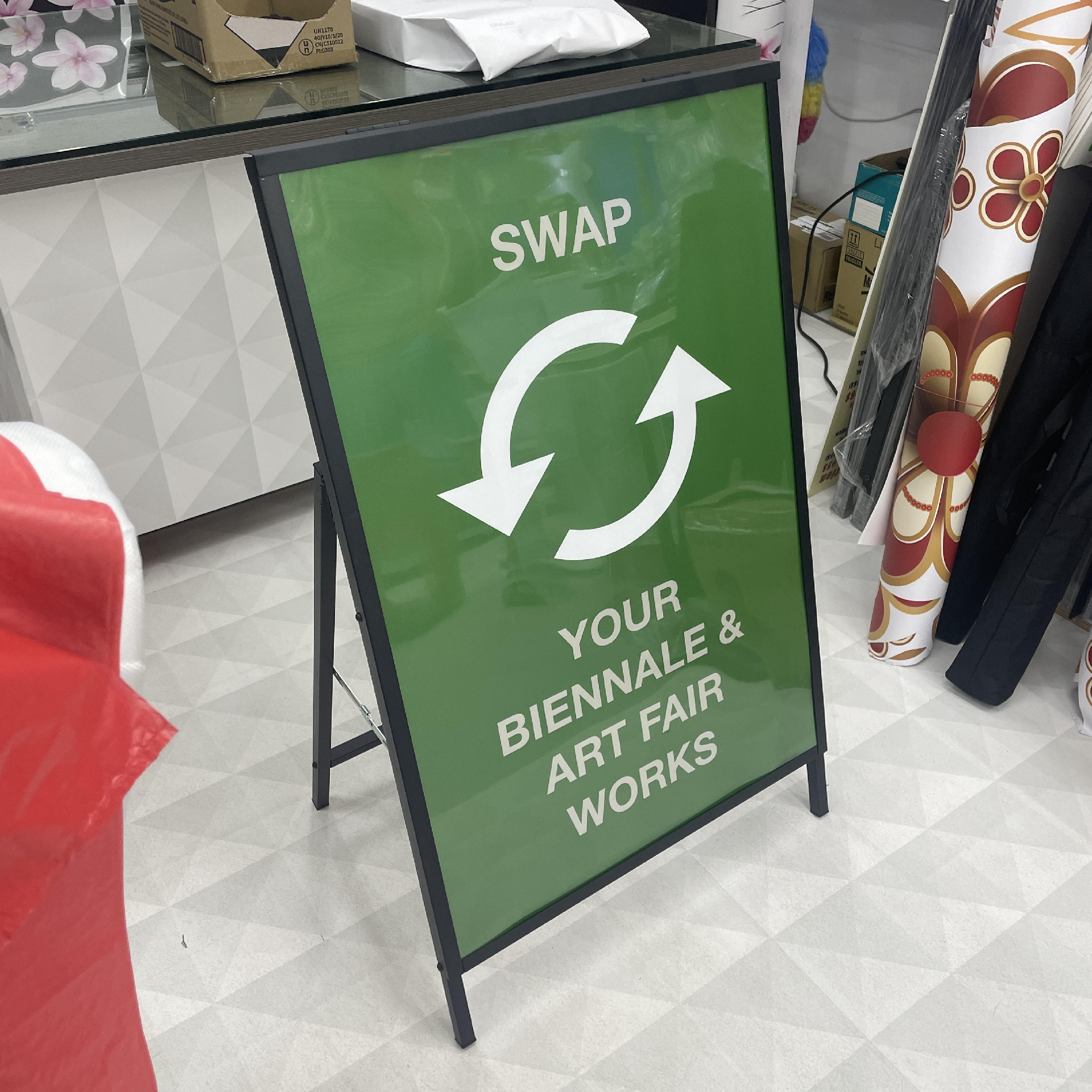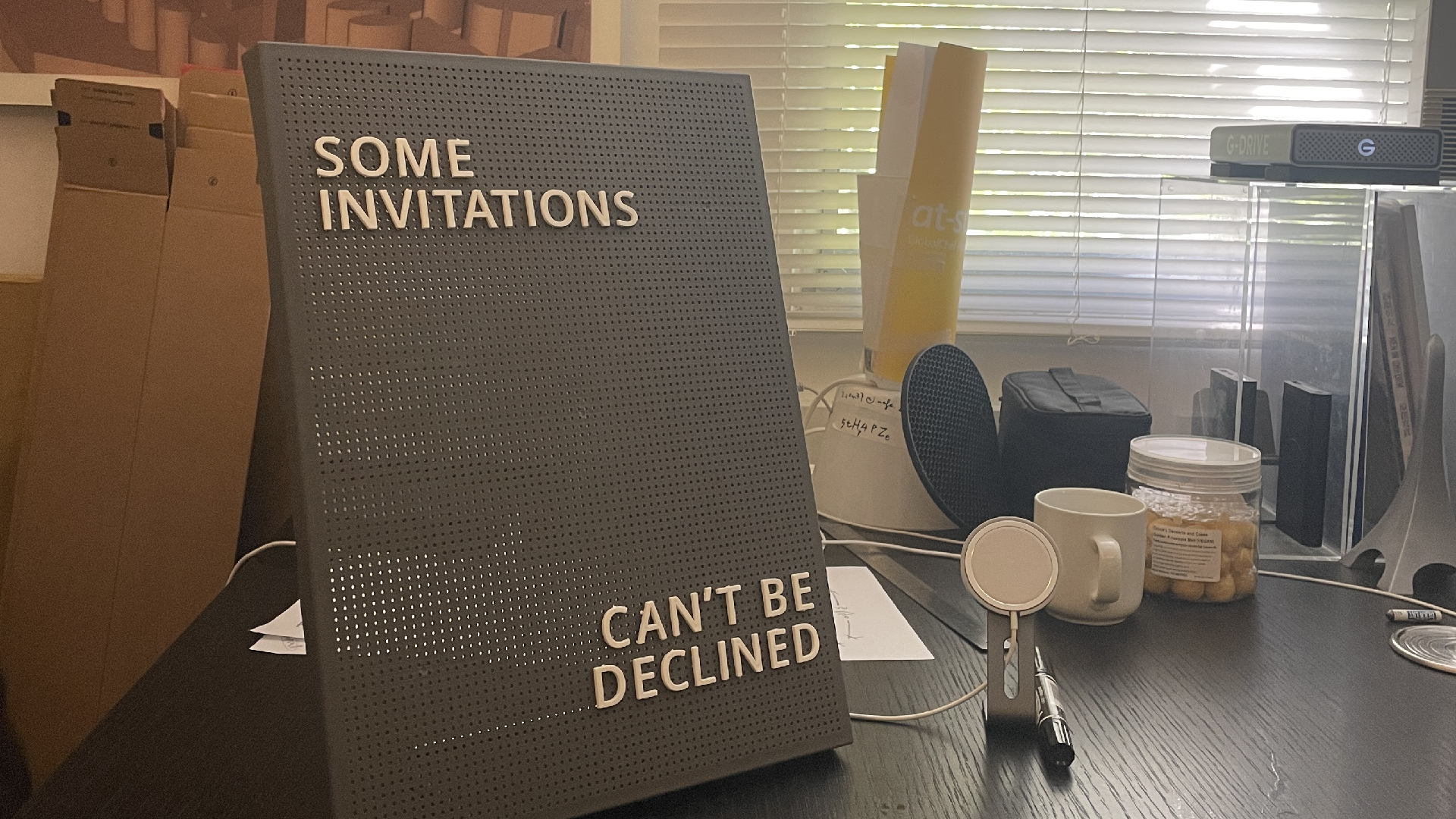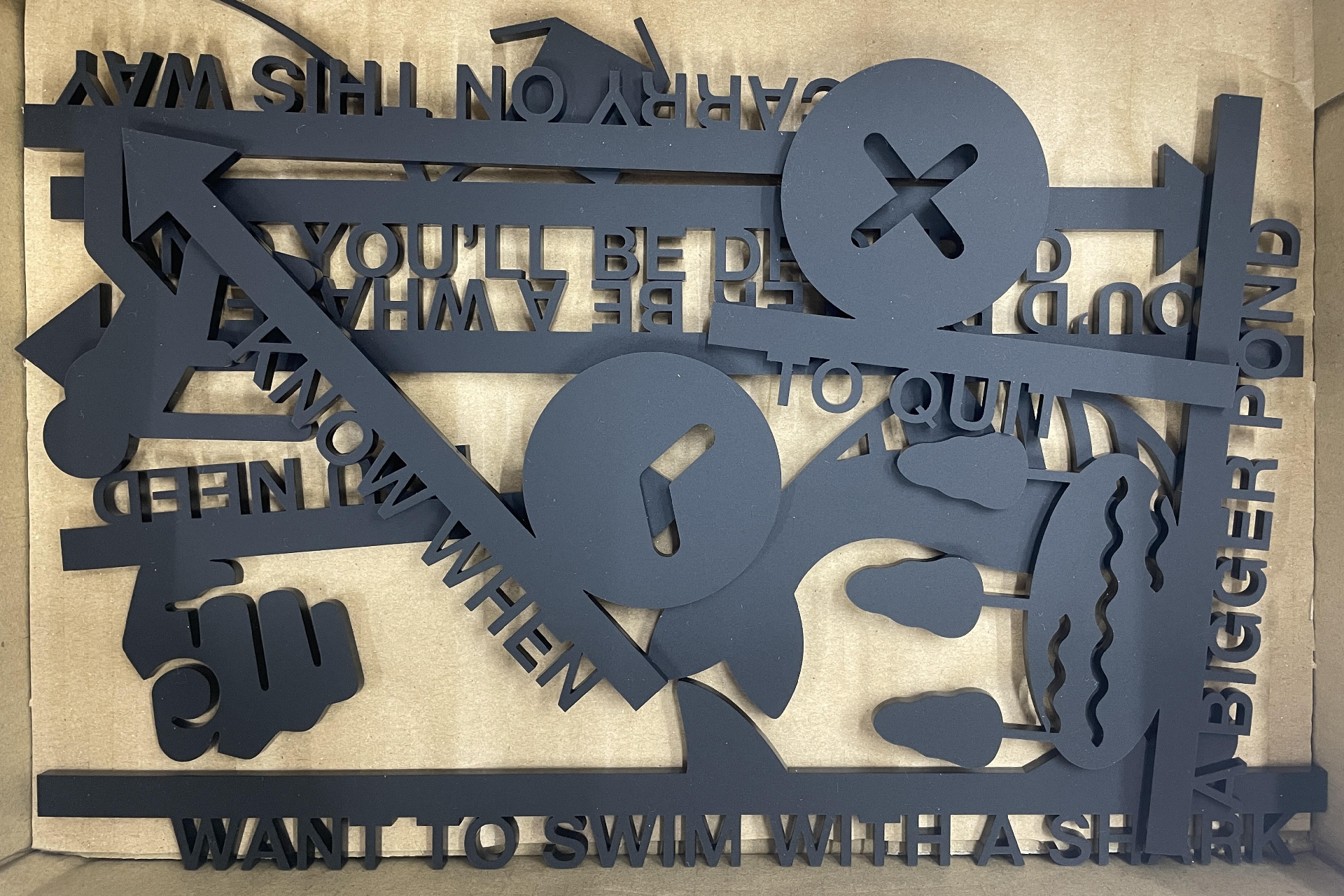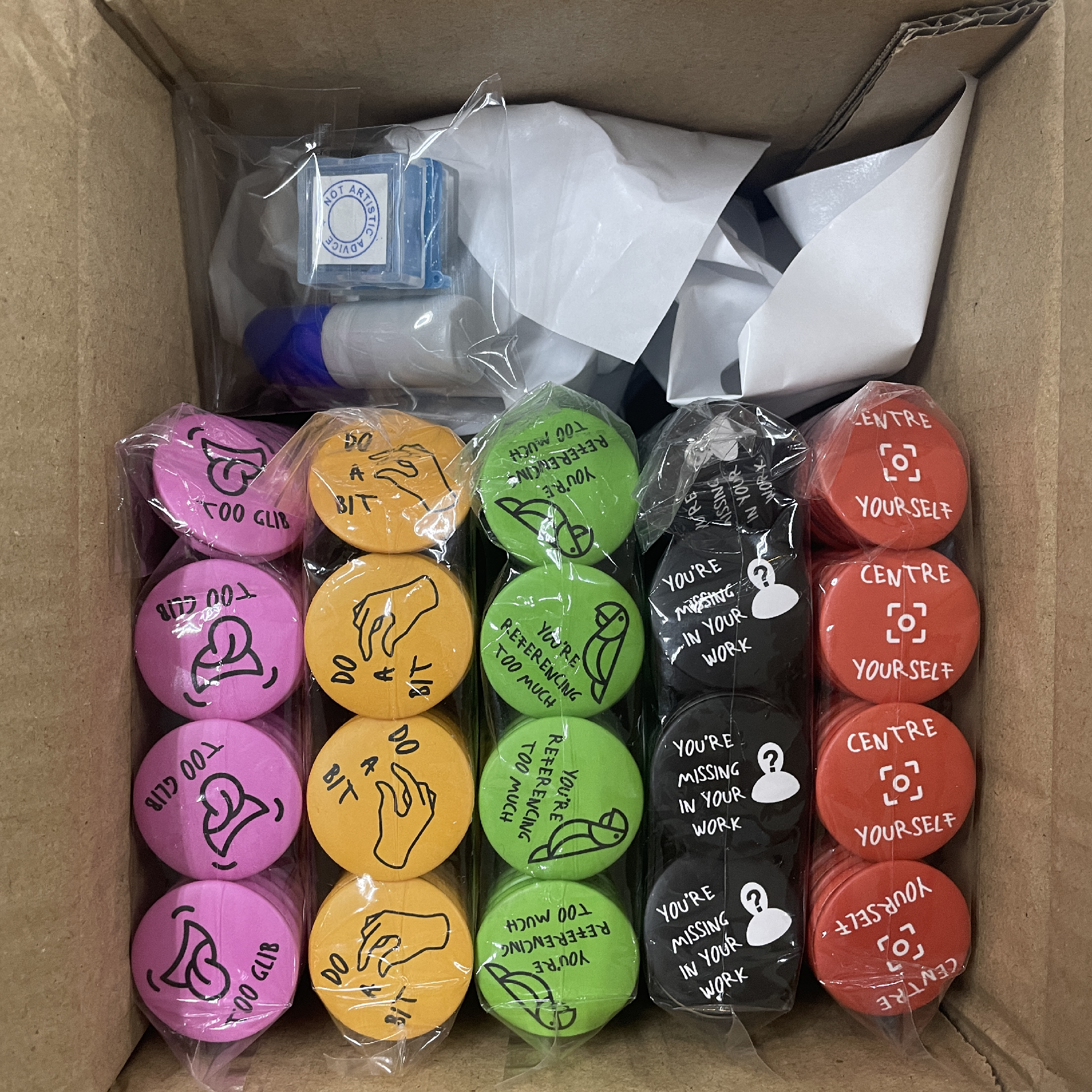






Title
Not Artistic Advice
Year
2022
Medium
Mixed formats
Dimensions
Dimensions variable
Click here for more information on the mediums and dimensions of this series.
Not Artistic Advice
Year
2022
Medium
Mixed formats
Dimensions
Dimensions variable
Click here for more information on the mediums and dimensions of this series.
This work is an exploration of tips, opinions, and comments given to the artist during his two-decade-long art career. Some have been beneficial, while others were pointless or even harmful, whether they had been offered in privileged settings or freely dispensed with little care. The title, which references the oft-used disclaimer in discussions of personal financing (“This is not financial advice”), expresses a denial that in fact frames the invisible communication that circulates and sustains the dynamics of the art scene. This ‘invisibility’ is reflected in the artist’s use of “background formats”—including navigational signs, badges, and even safety vests worn by the gallery sitters—that appear to be extraneous elements in the exhibition, yet remain a constant presence that cannot be ignored. The work, in all its absurd humour, thus also functions as a mediation of personal and social biographies, offering a partial self-portrait against the backdrop of the art scene in Singapore.
Interview with the artist
Q Curators
Your works in the past few years have been especially focused on text and speech, and the way in which language or information is communicated. What has been driving you to investigate this as a medium?
There is a politics of language that structures power dynamics amongst people in any communicative context, sometimes in unfair ways. Among Singlish users, for instance, there is a difference between those who can and cannot code-switch between Singlish and “proper” English, which allows the former to come across as being more sophisticated, nuanced, or considerate than the latter. The perceived advantage of those with linguistic competence—the multi-linguists, the code switchers, the “better” speakers or writers—becomes directly associated, often in muddled and arbitrary ways, with moral and ethical judgments. Class inequality is often the elephant in the room when evaluating the worth of a person in and through language.
My relationship with language in my different roles in art has evolved over time. At first, I saw it as my mission to get the language part right. This was most evident in my earlier curatorial projects, for which much effort was put into the textual aspects of the project, not limited to titling, grammar, proper formatting, credits and acknowledgements, with the often unspoken aim of giving the impression of intelligence, diligence and reliability. Looking back now, these were pursued at the expense of surprise, autonomy, and insight.
My more recent artworks examine the limits of language in addressing everyday existence, in particular by developing physical and performative text pieces to stand in for what I could not articulate orally. One example is How Are Things (2018), a large-scale anamorphic text installation addressing MRT commuters from the grandstand of Woodlands Stadium. It was my attempt at reflecting on how such a greeting could be experienced in ways ranging from friendly to distressing.
My relationship with language in my different roles in art has evolved over time. At first, I saw it as my mission to get the language part right. This was most evident in my earlier curatorial projects, for which much effort was put into the textual aspects of the project, not limited to titling, grammar, proper formatting, credits and acknowledgements, with the often unspoken aim of giving the impression of intelligence, diligence and reliability. Looking back now, these were pursued at the expense of surprise, autonomy, and insight.
My more recent artworks examine the limits of language in addressing everyday existence, in particular by developing physical and performative text pieces to stand in for what I could not articulate orally. One example is How Are Things (2018), a large-scale anamorphic text installation addressing MRT commuters from the grandstand of Woodlands Stadium. It was my attempt at reflecting on how such a greeting could be experienced in ways ranging from friendly to distressing.
This work grew out of a collection of advice – whether good, useless, or even harmful – directed at your art practice or artworks. Why have you chosen to focus on this subject?
I have received quite a lot of advice in my two-decade art career thus far. In the past two months, I have remembered about seventy pieces, and I have barely scratched the surface. Some of the pieces of advice were given upon my request, in youthful innocence or out of desperation, but most of them were unsolicited. I also noticed some ironies in the advice I have received—sometimes they seem to be more about the advisor than the advisee, and sometimes the simplest advice (e.g. “breathe”) actually works for me! Importantly, my opinion and understanding of the different words of advice have changed over time.
Like gossip and rumour, art advice exists outside of the public face of art, yet it is the engine that drives and animates artistic identities and relationships. I saw this exhibition as an apt platform to investigate what advice does in the art context. A lot of advice circulated in art and mainstream society are like imperfect copies of one another, which sustain various key myths about artists—consistency, grit, signature style, to name a few—which could be restrictive to an artist’s or a scene’s development. Advice given in the art context often goes undocumented; the effects are invisible, whether benefits are reaped or damage is done. In the best case scenario, a useful piece of advice contributes to an artist's self-awareness, development and achievements. Often though, if the advice is not understood, examined and reflected on in context, it could be harmful.
Like gossip and rumour, art advice exists outside of the public face of art, yet it is the engine that drives and animates artistic identities and relationships. I saw this exhibition as an apt platform to investigate what advice does in the art context. A lot of advice circulated in art and mainstream society are like imperfect copies of one another, which sustain various key myths about artists—consistency, grit, signature style, to name a few—which could be restrictive to an artist’s or a scene’s development. Advice given in the art context often goes undocumented; the effects are invisible, whether benefits are reaped or damage is done. In the best case scenario, a useful piece of advice contributes to an artist's self-awareness, development and achievements. Often though, if the advice is not understood, examined and reflected on in context, it could be harmful.
What was your motivation for presenting the advice in various textual forms and different modes of dissemination?
The different formats mimic the different contexts that advice is received and responded to. Some advice may be given in passing during a project discussion or a casual chat, while others in a more sustained or professional setting of mentorship or therapy. One’s responses could also range from total rejection to full embracement to plain acknowledgement.
Each format also possesses unique implications. Navigation signs, for instance, are crucial for first-time visitors to a building, and can cause one to go around in circles if poorly executed. But they continue to exist in your absence or departure, much like divine truths or water vapour suspended mid-air, hovering over your existence like a kind of restrictive conscience. Still, if there is a consistent thread across the different pieces of advice represented in this project, it would be abstraction. They all have missing details, such as context or the identity of the advisors. This is intentional, aimed at creating open interpretations, which advice in reality tends to suppress.
Through a range of formats in this work, I want to purposefully disorientate, confuse, stop visitors in their tracks, or lead them away from their intentions. Hopefully they respond with a touch of humour, even if filled with frustration. No piece of advice in this project can promise good outcomes, but I feel that I have achieved my aim if they create some chuckles.
Each format also possesses unique implications. Navigation signs, for instance, are crucial for first-time visitors to a building, and can cause one to go around in circles if poorly executed. But they continue to exist in your absence or departure, much like divine truths or water vapour suspended mid-air, hovering over your existence like a kind of restrictive conscience. Still, if there is a consistent thread across the different pieces of advice represented in this project, it would be abstraction. They all have missing details, such as context or the identity of the advisors. This is intentional, aimed at creating open interpretations, which advice in reality tends to suppress.
Through a range of formats in this work, I want to purposefully disorientate, confuse, stop visitors in their tracks, or lead them away from their intentions. Hopefully they respond with a touch of humour, even if filled with frustration. No piece of advice in this project can promise good outcomes, but I feel that I have achieved my aim if they create some chuckles.

Biography


